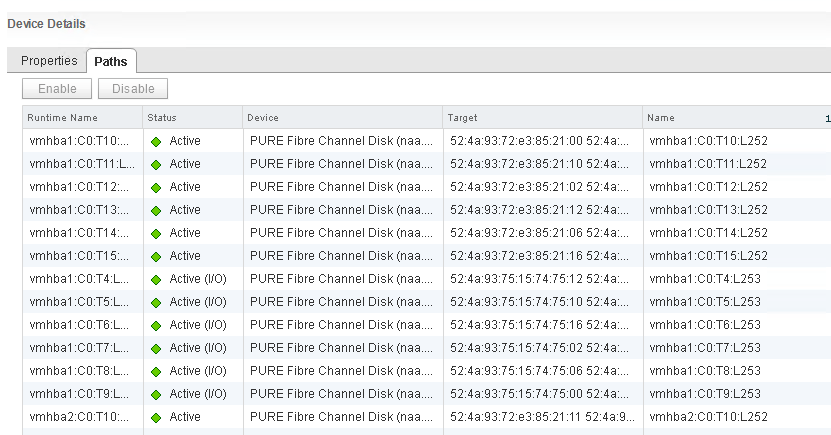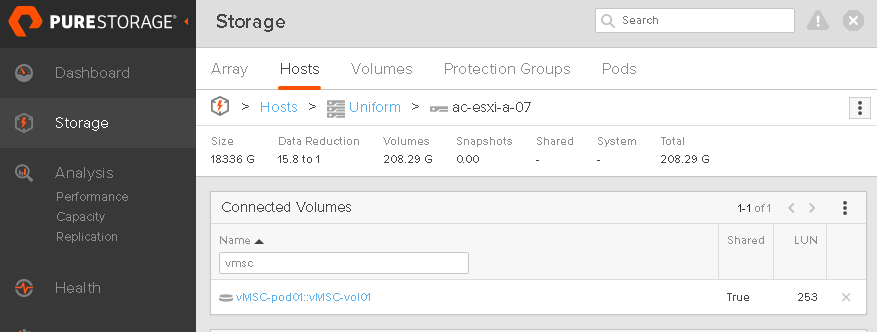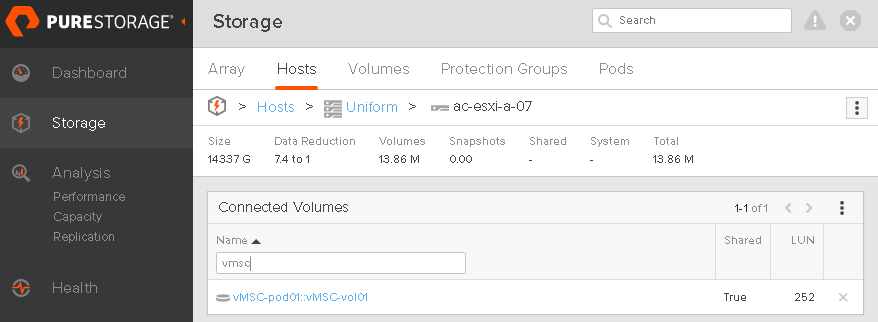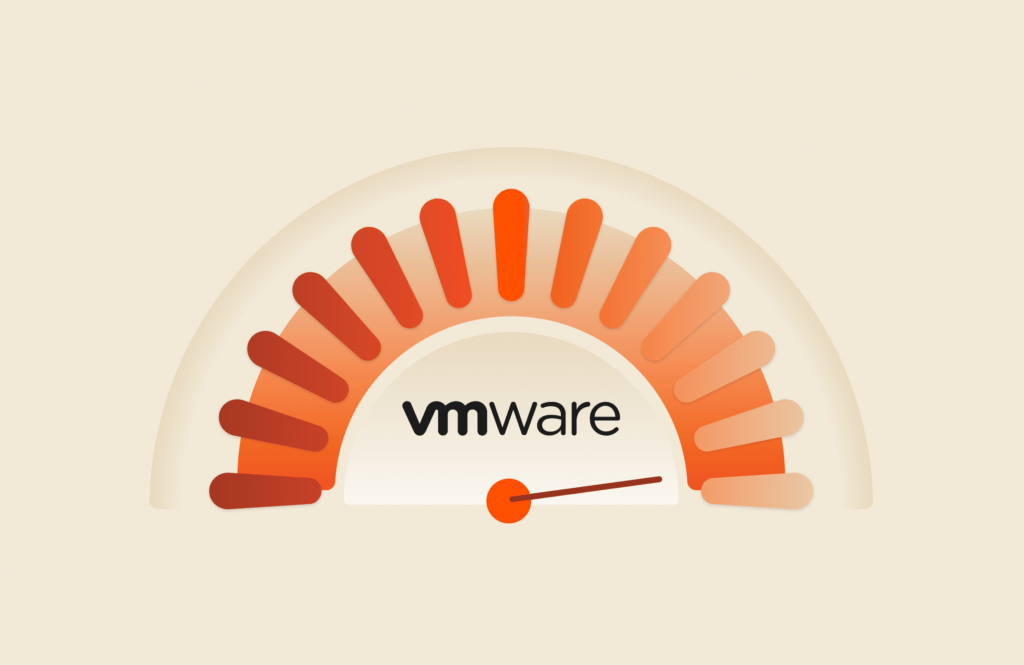Having consistent LUN IDs for volumes in ESXi has historically been a gotcha–though over time this requirement went away.
For example:
- 2012 https://cormachogan.com/2012/09/26/do-rdms-still-rely-on-lun-id/
- 2013 https://cormachogan.com/2013/12/11/vsphere-5-5-storage-enhancement-part-7-lun-idrdm-restriction-lifted/
These days, the need for consistent LUN IDs is mainly gone. The lingering use case for this is Microsoft Clustering and how persistent SCSI reservations are handled. The below KB doesn’t mention 6.5, but I believe it to still be relevant to 6.5:
https://kb.vmware.com/s/article/2054897
There are two places having consistent LUN IDs have mattered. Same LUN ID for a volume within a host (so each path shows the same LUN ID for a volume) and also having the same LUN IDs for a volume on different hosts.
Today, device recognition is used via information in the page 83 of the device VPD. This has things like the device serial number (sometimes called a WWN). This, in combination with the vendor Organizational Uinque Identifier OUI, creates what is called a Network Address Authority. This does not use the LUN ID in calculation.
naa.624a93701037b35fd0ef40a5000122a0
The OUI for Pure Storage is 2439a70
https://www.wireshark.org/tools/oui-lookup.html can show you this. My volume serial number is 1037b35fd0ef40a5000122a0
So this allows ESXi to identify volume uniquely without using the LUN ID anymore. Though they still do keep some old identifiers that do use the LUN ID to generate the ID. Namely the VML, or VMware Legacy identifier.
vml.0200fd0000624a93701037b35fd0ef40a5000122a0466c61736841
This is a much longer ID and depending on the ESXi version, which use the LUN ID in a few places. This KB article explains:
https://kb.vmware.com/s/article/2078730
In short, the LUN ID is used in the early part of the ID and in version prior to 5.5 used as part of a hash for the tail portion. In 5.5 and later, ESXi just zeroed out the LUN portion to the hash wouldn’t change due to LUN ID. But the earlier part of the ID that used the ID does change. If you had different LUN IDs, multiple VMLs would be generated for a volume.
Now on the FlashArray, we ensure LUN ID consistency when presenting a volume to a host or a group of hosts. But with our release of ActiveCluster, you could present the same volume from two arrays at once (using active/active replication) when configured in a Uniform configuration. This introduced the possibility to use one LUN ID for a device’s paths on one FlashArray and a different LUN ID for the paths to the other FlashArray.
You can see in the above screen shots, from my preferred FlashArray (the one local to my host) uses LUN ID 253, and the paths to my remote FlashArray use LUN ID 253.
In this case, my host will only use the remote paths if the local one goes away.
Anyways, the point is that since I have two different LUN IDs for this device on this host, ESXi generates two VMLs:
You can see the LUN ID in it if you look at the start of it:
vml.0200fd
vml.0200fc
Hexidecimal FC is 252 in decimal and FD is 253.
So why am I bringing this up if it doesnt matter any more? Well in ESXi 6.5 support for multiple VMLs were dropped. So when a device was discovered and it had more than one LUN ID on that host, ESXi would not claim it and would not use it. You’d see messages like in this KB article:
https://kb.vmware.com/s/article/2148265
Messages like:
|
1 2 3 4 |
ScsiUid: 403: Existing device naa.<xxxx> already has uid vml.<xxxx> ScsiDevice: 4163: Failing registration of device ‘naa.<xxxx>’ ScsiDevice: 4165: Failed to add legacy uid vml.<xxxx> on path vmhba<xxxx>: Already exists WARNING: NMP: nmp_RegisterDevice:851: Registration of NMP device with primary uid ‘naa.<xxxx>’ failed. Already exists |
The insidious thing about this, was that let’s say you added a device on a certain number of paths. In my case, I added it from only my first array and all paths had the same LUN IDs. ESXi would be great with that and it could be used. But then later on, I enabled active-active replication and then presented paths to it from the second array. But these paths had a different LUN ID. ESXi 6.5 would actually be fine with that. This is because the device has already been claimed, and it seems VML addresses are only added when the device is first claimed, but not when just new paths are added. Since basically nothing uses VMLs, things would work fine.
But then you reboot. This causes all devices to be reclaimed. Oh, ESXi sees different LUN IDs, doesn’t like multiple ones, so it doesnt claim the device. So that device becomes unavailable after a reboot even though it worked before.
So the above KB article claims this is an expected result. This is not true, it is a regression bug. And it has been fixed in ESXi 6.5 U1:
https://docs.vmware.com/en/VMware-vSphere/6.5/rn/vsphere-esxi-651-release-notes.html
|
1 2 3 |
“<strong>After installation or upgrade certain multipathed LUNs will not be visible</strong> If the paths to a LUN have different LUN IDs in case of multipathing, the LUN will not be registered by PSA and end users will not see them. “ |
So, in short, upgrade to ESXi 6.5 U1. Especially if you are using uniform active/active replication.








